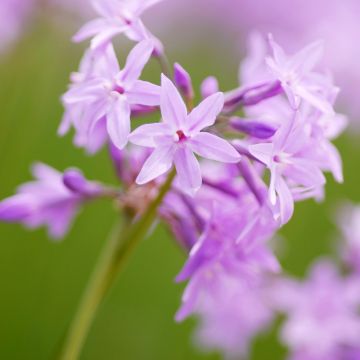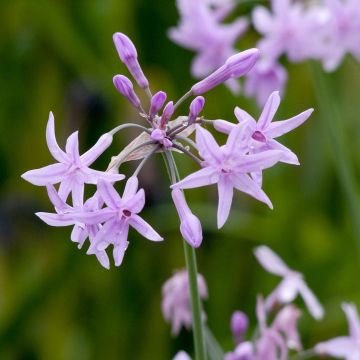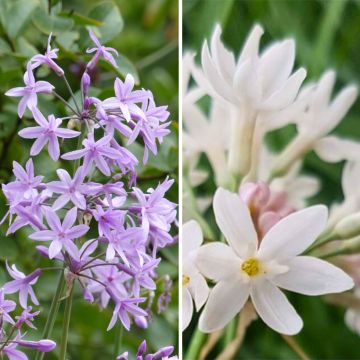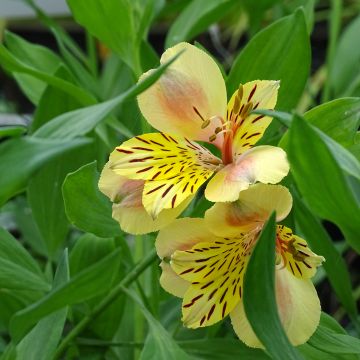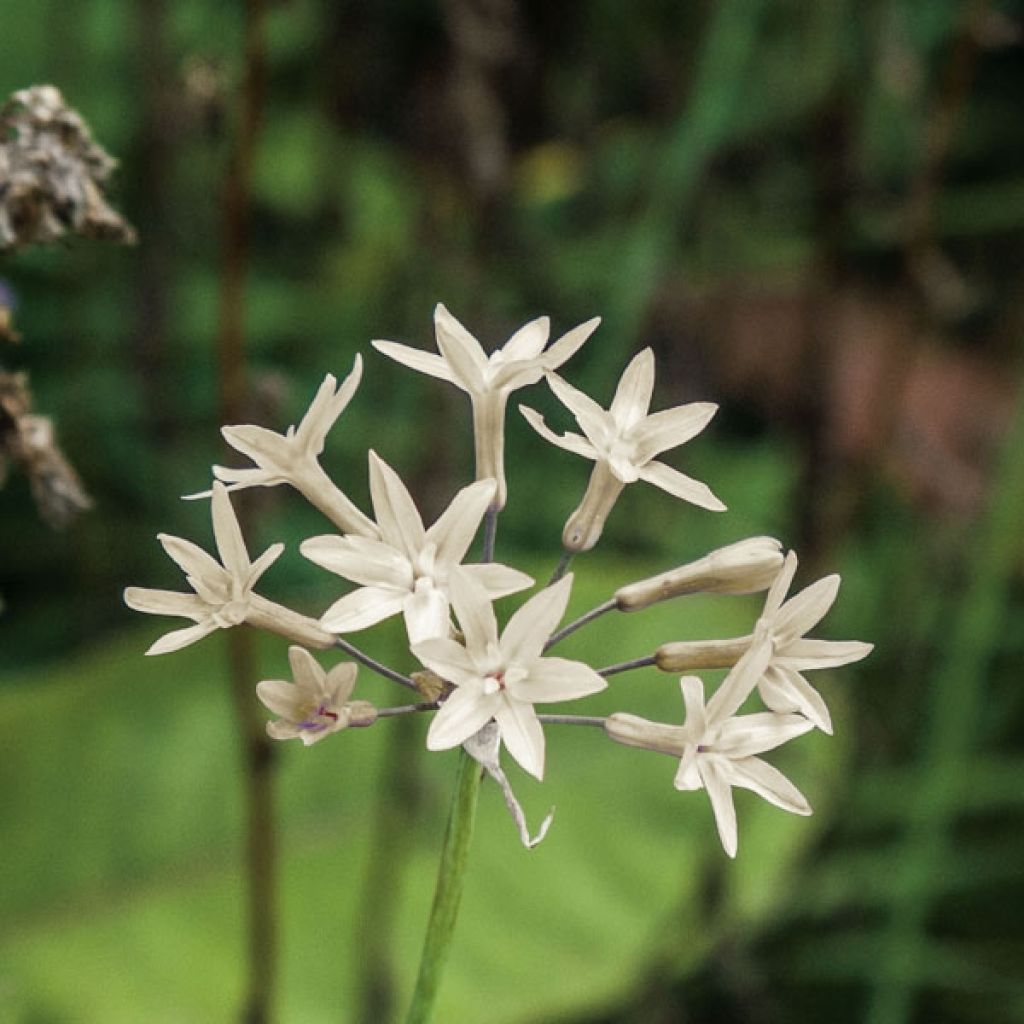

Tulbaghia fragrans Alba
Tulbaghia fragrans Alba
Tulbaghia fragrans Alba
Sweet Garlic
Never shot, but perfect customer service: a refund was issued! Top.
Elisabeth, 08/05/2022
Special offer!
Receive a €20 voucher for any order over €90 (excluding delivery costs, credit notes, and plastic-free options)!
1- Add your favorite plants to your cart.
2- Once you have reached €90, confirm your order (you can even choose the delivery date!).
3- As soon as your order is shipped, you will receive an email containing your voucher code, valid for 3 months (90 days).
Your voucher is unique and can only be used once, for any order with a minimum value of €20, excluding delivery costs.
Can be combined with other current offers, non-divisible and non-refundable.
Why not try an alternative variety in stock?
View all →This plant carries a 12 months recovery warranty
More information
We guarantee the quality of our plants for a full growing cycle, and will replace at our expense any plant that fails to recover under normal climatic and planting conditions.
Would this plant suit my garden?
Set up your Plantfit profile →
Description
Tulbaghia fragrans Alba is a perennial bulbous plant with a long, highly fragrant summer flowering! Its umbels, gracefully swaying at the end of long stems, are larger than those of the purple Tulbaghia and bear small, tubular ivory-white flowers crowned with a cream centre. It has fairly wide, ribbon-like grey-green leaves that resemble a small agapanthus with its semi-spreading habit. Hardy down to -10°C (14°F), it is an excellent plant for coastal borders where it will benefit from regular rainfall and mild temperatures. In regions with harsher winters, use it to create flowering pots that will perfume the patio or balcony and can be stored away from frost.
Tulbaghia belongs to the Alliaceae family, just like leeks, garlic, and onions. It is native to South Africa, specifically the meadows of Lesotho and Swaziland, which have rather dry winters and rainy summers. It is a herbaceous perennial plant with a fleshy tuberous root forming a clump of thin, ribbon-like leaves, more or less evergreen depending on the winter temperatures, with a long summer flowering period.
The 'Alba' cultivar develops into a moderately spreading clump that widens over time through its rhizomes. The flowering plant measures about 50 cm (20in) in height and 30 cm (12in) in width. Its particularly long flowering period begins from April to June depending on the climate and lasts until the arrival of cold weather in September-October. In milder regions, it can flower almost all year round. Clumps of leaves emerge from the floral stems bearing large false umbels of small tubular flowers that resemble narcissus flowers, opening into 6-pointed white petals around a cream-yellow centre. The flowers emit a particularly powerful honey scent at dusk. They are followed by the formation of seeds that can self-sow. It has a clump of ribbon-like, wide, upright linear leaves, grey-green in colour, flexible enough to arch slightly, giving it an agapanthus-like appearance.
Tulbaghia fragrans 'Alba' is a very attractive plant appreciated for its extended flowering that lasts until autumn and brings a bit of colour to the garden or patio during a period of the year with few blooms. Along the edge of a bed or path, or in a rockery, it can replace agapanthus or be combined with them, choosing from the most compact varieties (Agapanthus Silver Moon, Golden Drop...). As it is quite sensitive to cold, especially in moist soil during winter, it is often preferable to grow it in a pot, except in very mild climates. This plant thrives outdoors in summer, exposed to light but without direct sunlight. It is a good coastal plant, tolerating sandy soils and sea spray. The most favourable climate for it is a mild oceanic climate. In Mediterranean regions, it will require regular watering in summer.
Report an error about the product description
Flowering
Foliage
Plant habit
Botanical data
Tulbaghia
fragrans
Alba
Alliaceae
Sweet Garlic
South Africa
Other Tulbaghia
View all →Planting and care
Tulbaghia appreciates well-drained soils, whether they are slightly acidic, neutral or slightly calcareous. It prefers light and sandy soils. Its hardiness, -12°C (10.4°F) will be reduced in wet and poorly drained soils in winter. A mixture of leaf compost and sand makes a good substrate for its cultivation. Choose a sunny or, at most, partially shaded position in the hottest and sunniest regions. It appreciates moist soils during its flowering period (spring-summer), but drier in autumn and winter. It tolerates sea spray perfectly. Repot your young plants in a pot of around 20 cm containing a third compost, a third leaf compost, and a third sand. Leave them in a warm and well-lit place (but without direct sunlight) until the last frosts. You can then take your pot outside. Bring them indoors at the beginning of autumn when temperatures start to drop. In the ground, space the plants 20cm (8in) apart. In autumn, cut back the clumps to 3 or 4 cm (1 or 2in) from the ground and mulch heavily to protect from the cold. In a pot: during the growth period, water two to three times a week and apply liquid fertiliser at least every 15 days to achieve good flowering. In winter, reduce watering. Repot every three years.
Planting period
Intended location
Care
-
, onOrder confirmed
Reply from on Promesse de fleurs
Similar products
Haven't found what you were looking for?
Hardiness is the lowest winter temperature a plant can endure without suffering serious damage or even dying. However, hardiness is affected by location (a sheltered area, such as a patio), protection (winter cover) and soil type (hardiness is improved by well-drained soil).

Photo Sharing Terms & Conditions
In order to encourage gardeners to interact and share their experiences, Promesse de fleurs offers various media enabling content to be uploaded onto its Site - in particular via the ‘Photo sharing’ module.
The User agrees to refrain from:
- Posting any content that is illegal, prejudicial, insulting, racist, inciteful to hatred, revisionist, contrary to public decency, that infringes on privacy or on the privacy rights of third parties, in particular the publicity rights of persons and goods, intellectual property rights, or the right to privacy.
- Submitting content on behalf of a third party;
- Impersonate the identity of a third party and/or publish any personal information about a third party;
In general, the User undertakes to refrain from any unethical behaviour.
All Content (in particular text, comments, files, images, photos, videos, creative works, etc.), which may be subject to property or intellectual property rights, image or other private rights, shall remain the property of the User, subject to the limited rights granted by the terms of the licence granted by Promesse de fleurs as stated below. Users are at liberty to publish or not to publish such Content on the Site, notably via the ‘Photo Sharing’ facility, and accept that this Content shall be made public and freely accessible, notably on the Internet.
Users further acknowledge, undertake to have ,and guarantee that they hold all necessary rights and permissions to publish such material on the Site, in particular with regard to the legislation in force pertaining to any privacy, property, intellectual property, image, or contractual rights, or rights of any other nature. By publishing such Content on the Site, Users acknowledge accepting full liability as publishers of the Content within the meaning of the law, and grant Promesse de fleurs, free of charge, an inclusive, worldwide licence for the said Content for the entire duration of its publication, including all reproduction, representation, up/downloading, displaying, performing, transmission, and storage rights.
Users also grant permission for their name to be linked to the Content and accept that this link may not always be made available.
By engaging in posting material, Users consent to their Content becoming automatically accessible on the Internet, in particular on other sites and/or blogs and/or web pages of the Promesse de fleurs site, including in particular social pages and the Promesse de fleurs catalogue.
Users may secure the removal of entrusted content free of charge by issuing a simple request via our contact form.
The flowering period indicated on our website applies to countries and regions located in USDA zone 8 (France, the United Kingdom, Ireland, the Netherlands, etc.)
It will vary according to where you live:
- In zones 9 to 10 (Italy, Spain, Greece, etc.), flowering will occur about 2 to 4 weeks earlier.
- In zones 6 to 7 (Germany, Poland, Slovenia, and lower mountainous regions), flowering will be delayed by 2 to 3 weeks.
- In zone 5 (Central Europe, Scandinavia), blooming will be delayed by 3 to 5 weeks.
In temperate climates, pruning of spring-flowering shrubs (forsythia, spireas, etc.) should be done just after flowering.
Pruning of summer-flowering shrubs (Indian Lilac, Perovskia, etc.) can be done in winter or spring.
In cold regions as well as with frost-sensitive plants, avoid pruning too early when severe frosts may still occur.
The planting period indicated on our website applies to countries and regions located in USDA zone 8 (France, United Kingdom, Ireland, Netherlands).
It will vary according to where you live:
- In Mediterranean zones (Marseille, Madrid, Milan, etc.), autumn and winter are the best planting periods.
- In continental zones (Strasbourg, Munich, Vienna, etc.), delay planting by 2 to 3 weeks in spring and bring it forward by 2 to 4 weeks in autumn.
- In mountainous regions (the Alps, Pyrenees, Carpathians, etc.), it is best to plant in late spring (May-June) or late summer (August-September).
The harvesting period indicated on our website applies to countries and regions in USDA zone 8 (France, England, Ireland, the Netherlands).
In colder areas (Scandinavia, Poland, Austria...) fruit and vegetable harvests are likely to be delayed by 3-4 weeks.
In warmer areas (Italy, Spain, Greece, etc.), harvesting will probably take place earlier, depending on weather conditions.
The sowing periods indicated on our website apply to countries and regions within USDA Zone 8 (France, UK, Ireland, Netherlands).
In colder areas (Scandinavia, Poland, Austria...), delay any outdoor sowing by 3-4 weeks, or sow under glass.
In warmer climes (Italy, Spain, Greece, etc.), bring outdoor sowing forward by a few weeks.




































